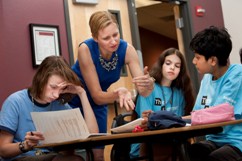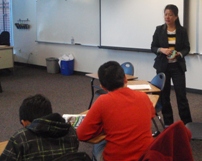| |
One of the current trends in education is character development and how it can be used to teach students about hope, grit, zest, optimism, self-control and curiosity – just to name a few. We wanted to share with you some of the factors involved in teaching character strengths, especially the benefits for gifted students. We are also including some interesting information about brain development differences in boys and girls, and
how these can affect student behavior. We hope everyone has a wonderful rest of the school year!
 Guest
Q&A – Dr. Janette Boazman Guest
Q&A – Dr. Janette Boazman
Janette is an assistant professor of education and the chair of education at the University of Dallas. Her research focuses on the academic and psychological factors that lead to academic and career success, and to the personal well-being of the gifted and talented in K-12 schools, college, and across the lifespan.
Please explain the importance of teaching character development, especially traits such as hope and grit. How can educators foster these traits in the classroom?
It does not matter if you are a parent, teacher, or administrator; we all want the same thing. We want our children to be happy, healthy, and to be in education programs that best fit their academic, physical, social, and emotional needs. We want them to live an integral and productive life. We want our students to move toward thriving across the lifespan.
The path to character development is through positive friendships and positive relationships with others, this includes teachers. Teaching character and helping students develop positive character traits aids in the development of talent, integrity, and ultimately happiness. Through knowledge of what constitutes good character, gifted individuals are better equipped to develop good character and recognize good character in those with whom they align themselves. Those positive relationships help shape the character of the individual and aid in talent development and the development of an integral life.
To read Dr. Boazman’s
full response, including underlying theories linking talent
development to character development,
click here.
 Hope and Grit Hope and Grit
Two important character traits that are currently being researched in relation to education are hopefulness and grit. C.R. Snyder (1994) defines hope in terms of it being a cognitive construct that is goal oriented and is created from the joining of two elemental pieces, 1) agency thinking, and 2) pathways thinking. Agency thinking is the personal belief in one’s ability to initiate and maintain actions toward goal achievement. Pathways thinking is the personal belief in one’s ability to create routes to goal achievement. When an individual has agentic thinking coupled with the ability to see and create multiple routes to a goal then the individual has hope of goal achievement.
Teaching gifted learners to be hopeful in the education setting includes explicit teaching of the components of hopeful thought as defined by Snyder (1994). Instructors and parents should have students set long-term and short-term goals, identify pathways toward the goals, and scaffolding the movement and evaluation of pathways as movement toward goals occurs. Instructors and parents should help students build positive feelings about their capacity to move toward goals. They need to give students opportunities to overtly evaluate their feeling of capacity as they move toward goal achievement.
Grit is a newer character term being used in education. The movement for the teaching and student development of grit is gaining steam in education circles. Angela Duckworth coined the term grit (Duckworth, Peterson, Matthews, & Kelly, 2007) and defines it as passion and perseverance toward goal achievement over a long period of time.
Explicitly teaching students that sticking with goals to attainment is important to their development of grit. Allowing struggle helps the student experience how important tenacity and perseverance are. Educators should teach students about intrinsic motivation and expect intrinsic motivation. They must help students find and develop their passions. It is necessary for educators to focus on altering students’ attitudes about what is possible and bring them to the belief that the struggle will pay off.
Please
click here to read the full response by Dr. Boazman.
What do educators need to know about the differences in cognitive development between boys and girls?
Gender and education research has begun to show a mismatch between boys’ and girls’ learning brains and how education is being delivered. The function and development of the lobes in the cerebral cortex are different for boys and girls. Girls have statistically significant differences in cortical development and use of the frontal, temporal, and parietal lobes of the brain. For girls, the frontal lobe develops more quickly than the frontal lobe of boys which means that girls make fewer impulsive decisions and girls more readily and efficiently use the frontal, temporal, and parietal lobes of the brain. Boys show a significant difference in the use of the cortex of the cerebellum, the part of the brain that receives information from the sensory systems, the spinal cord, and other parts of the brain that regulate motor movement. It coordinates voluntary movement. This gives reason to the difference in movement by boys in the classroom.
 Neuroprocessing maps of the brain show lateralization of the boy brain activity with a pronounced difference from girls in the amount of cross hemisphere activity. A girl’s corpus callosum is up to 25 percent larger than a boy’s by adolescence. This allows more crosstalk in the brain which translates in to girls being better at multitasking, transitioning, and paying attention. Girls have stronger neural connectors than boys in their temporal lobes. These stronger neural connectors in the female brain allow for more sensually detailed memory storage, better listening skills, better discrimination among tones of voice, and greater use of detail in writing assignments. A girl’s hippocampus is larger increasing the girls’ learning advantage, especially in language arts. Neuroprocessing maps of the brain show lateralization of the boy brain activity with a pronounced difference from girls in the amount of cross hemisphere activity. A girl’s corpus callosum is up to 25 percent larger than a boy’s by adolescence. This allows more crosstalk in the brain which translates in to girls being better at multitasking, transitioning, and paying attention. Girls have stronger neural connectors than boys in their temporal lobes. These stronger neural connectors in the female brain allow for more sensually detailed memory storage, better listening skills, better discrimination among tones of voice, and greater use of detail in writing assignments. A girl’s hippocampus is larger increasing the girls’ learning advantage, especially in language arts.
Where the female brain uses the cortical areas of the brain for verbal and emotive functioning, the male brain uses these areas for spatial and mechanical functioning. This makes boys want to move objects through space – balls, model airplanes, their arms, their legs. Boys have less serotonin and oxytocin, the primary human bonding chemical, than girls. This makes them more likely to be physically impulsive and less likely to combat their natural impulsiveness which makes it hard for boys to sit still and easy for them to turn and chat with a friend. The boy brain needs to enter a rest state in order to recharge, renew, and reorient itself. This rest state may look like falling asleep, tapping pencils or fidgeting in order to stay attentive. The male brain is better suited for diagrams, pictures, symbols, abstractions, and objects moving through space than for the monotony of words.
To read Dr. Boazman’s full response to this question,
click here.
How can educators apply this information (boy/girl cognitive development) to help students learn more effectively?
One option teachers can use to help boys with their need to move and be active in the classroom is Whole Brain Teaching and Learning techniques. These generally allow for more movement, a fast pace, and interaction in the learning. If possible, allow boys space to spread out if they need to. Allowing boys to move during the learning is important (Gurian, 2011). This movement can be as simple as allowing them to stand at their desk while answering or asking questions. Have a variety of seating options in the classroom. For example classroom seating might include traditional desks with traditional chairs, tables with chairs, or rugs for use when sitting on the floor. There are teachers who offer an exercise ball option as a replacement for a traditional chair. Varied seating options may lead to a classroom with more movement and noise but boys can actually stay more focused with a little bit of movement.
 Boys are also better able to verbalize when they are “doing something.” Make stress balls available for students during class. Boys are able to follow instructions better when they are listed or bulleted instead of written in paragraph form. Don’t allow the boy brain to go into the rest state. Limit the teacher talk to intervals of 10 minutes with activities interspersed. Increase experiential learning by incorporating problem based learning projects. Let boys and girls choose topics that appeal to them by giving greater choice in what they read and write. Recognize that action, competition, and heroism are of interest to the boys and allow learning through action and competition. Use strategic grouping, offer single-gender learning environments by using single-gender groupings for different purposes in coeducational settings.
To read Dr. Boazman’s full response,
click here. Boys are also better able to verbalize when they are “doing something.” Make stress balls available for students during class. Boys are able to follow instructions better when they are listed or bulleted instead of written in paragraph form. Don’t allow the boy brain to go into the rest state. Limit the teacher talk to intervals of 10 minutes with activities interspersed. Increase experiential learning by incorporating problem based learning projects. Let boys and girls choose topics that appeal to them by giving greater choice in what they read and write. Recognize that action, competition, and heroism are of interest to the boys and allow learning through action and competition. Use strategic grouping, offer single-gender learning environments by using single-gender groupings for different purposes in coeducational settings.
To read Dr. Boazman’s full response,
click here.
For the entire text of Dr. Boazman's interview,
including references, please
click here to read this Davidson Gifted Database article.
|
|
|

 Guest
Q&A – Dr. Janette Boazman
Guest
Q&A – Dr. Janette Boazman Hope and Grit
Hope and Grit Neuroprocessing maps of the brain show lateralization of the boy brain activity with a pronounced difference from girls in the amount of cross hemisphere activity. A girl’s corpus callosum is up to 25 percent larger than a boy’s by adolescence. This allows more crosstalk in the brain which translates in to girls being better at multitasking, transitioning, and paying attention. Girls have stronger neural connectors than boys in their temporal lobes. These stronger neural connectors in the female brain allow for more sensually detailed memory storage, better listening skills, better discrimination among tones of voice, and greater use of detail in writing assignments. A girl’s hippocampus is larger increasing the girls’ learning advantage, especially in language arts.
Neuroprocessing maps of the brain show lateralization of the boy brain activity with a pronounced difference from girls in the amount of cross hemisphere activity. A girl’s corpus callosum is up to 25 percent larger than a boy’s by adolescence. This allows more crosstalk in the brain which translates in to girls being better at multitasking, transitioning, and paying attention. Girls have stronger neural connectors than boys in their temporal lobes. These stronger neural connectors in the female brain allow for more sensually detailed memory storage, better listening skills, better discrimination among tones of voice, and greater use of detail in writing assignments. A girl’s hippocampus is larger increasing the girls’ learning advantage, especially in language arts.
 Boys are also better able to verbalize when they are “doing something.” Make stress balls available for students during class. Boys are able to follow instructions better when they are listed or bulleted instead of written in paragraph form. Don’t allow the boy brain to go into the rest state. Limit the teacher talk to intervals of 10 minutes with activities interspersed. Increase experiential learning by incorporating problem based learning projects. Let boys and girls choose topics that appeal to them by giving greater choice in what they read and write. Recognize that action, competition, and heroism are of interest to the boys and allow learning through action and competition. Use strategic grouping, offer single-gender learning environments by using single-gender groupings for different purposes in coeducational settings.
To read Dr. Boazman’s full response,
Boys are also better able to verbalize when they are “doing something.” Make stress balls available for students during class. Boys are able to follow instructions better when they are listed or bulleted instead of written in paragraph form. Don’t allow the boy brain to go into the rest state. Limit the teacher talk to intervals of 10 minutes with activities interspersed. Increase experiential learning by incorporating problem based learning projects. Let boys and girls choose topics that appeal to them by giving greater choice in what they read and write. Recognize that action, competition, and heroism are of interest to the boys and allow learning through action and competition. Use strategic grouping, offer single-gender learning environments by using single-gender groupings for different purposes in coeducational settings.
To read Dr. Boazman’s full response,
 A Nation Empowered Now Available
A Nation Empowered Now Available
 Davidson Young
Scholars
Davidson Young
Scholars
 Educators Guild
Educators Guild